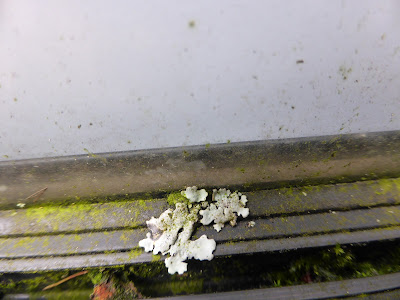O lazy, lazy me.
But nowadays I am more discerning.
 |
| Parmelina pastillifera |
 |
| Parmelia saxatilis |
This post is devoted to stories of my findings of Parmelina pastillifera. This species was uncommon once, but like many other lichen species it is spreading as the air has much less SO2 pollution now. Differences between the two species:
| Parmelina pastillifera | Parmelia saxatilis |
| No pseudocyphellae on thallus | Pseudocyphellae present (=whitish ridges on the thallus) |
| Isidia present | Isidia present (= lots of wart like projections that are a means of vegetative reproduction.) |
| The isidia are black/dark blue and are button shaped (mushroom shaped- a dark blob on a narrower stalk.) and thinly scattered on the thallus | The isidia are grey or dark grey, and finger tip shaped and are on the older parts of the thallus and can be very concentrated and numerous if the thallus is old. |
This is what it says on the Last Dragon web site:
A foliose lichen forming rosettes, lobes grey to blue-grey, often brownish towards lobe margins (as in Hypotrachyna), slightly lustrous, surface faintly marbled, usually developing conspicuous, button-like, blue-black or black isidia; apothecia apparently unknown in Britain. Widespread and locally frequent, especially in the south and west, generally on nutrient-rich bark, sometimes on rocks and other substrates.
I first discovered Parmelina pastillifera on a Rowan Tree on the grass triangle area beside the bridge beside Horton in Ribblesdale church in 2014, and keyed it out.
(N.B. I revisited the same tree in 2019 only to discover the lower limbs which supported the lichen had been cut off. Oh well! )
(N.B. I revisited the same tree in 2019 only to discover the lower limbs which supported the lichen had been cut off. Oh well! )
The following year I attended Allan Pentecost's course at Malham Tarn Field Centre. We were delighted to find Parmelina pastillifera .. on the moribund Slapton Minibus at Malham Tarn Field Centre beside High Stables. He pointed out that it was a new record for the Field Centre, and for the hectad (10 km square).
The minibus remained there for two years - serving a useful storage function for Field Centre bits and pieces, and potential minibus parts, and an excellent beautiful example of colonisation substrate with wonderful textures
Pictures from August 2015:
Location of the van:
 |
Vans in the foreground. It was the van on the right as you look at it. See Allan and students in the background studying scree looking for Farnoldia lichen
|
 |
| See vans in background by High Stables |
 |
| Parmelina pastillifera on van |
 |
| Parmelina pastillifera on van |
 |
| Parmelina pastillifera on van |
 |
| Snail trail on van |
Pictures of the same van in November 2016:
 |
| Campylopus introflexus (From Australia)- this moss gets everywhere |
 |
| I think this photo is a splendid example of different textures .. from the snail tracks to the reflection of the trees in the window |
Don't you?
 |
| See how the algae are increasing |
In my jogging / walking locally I have seen it on the stone wall on the road at Knight Stainforth, just near above the cafe.
The YNU trip to Marwick in Swaledale (14/05/2016) I stopped at some trees by the river Swale. and discovered Parmelina pastillifera's sister species: Parmelina tiliacea, P.tiliacea has isidia that are coraloid rather than button shaped.
Finally whilst going for a botany walk this December 2017 with members of PBA-Applied Ecology we found it on the gate just opposite the road from their office.
I saw the big foliose grey lichen and thought "Right, I'll show them the very common Parmelia saxatilis, it will be useful for them to know.
But lo, it turned out to be Parmelina pastillifera
 |
| P pastillifera on gate opposite PBA - Stackhouse Lane, 1/2 mile from Giggleswick/Settle |
 |
| P pastillifera on gate opposite PBA - Stackhouse Lane, 1/2 mile from Giggleswick/Settle |
In March 2019 I found it at Malham village Car Park on a tree I had surveyed c 10 year earlier (it had not been there then)
In May 2019 I found it on a wall under a tree in a hedge and in the tree
In July I found it on a bough of a tree in the parkland of Plas Cadnant on the 2019 BLS Anglesey trip
Actually that is the only place we found it on Anglesey - though it was an amazing tree I found it on with 16 species on one branch.
 |
| Parmelina pastillifera on Ash tree at Plas Cadnant, Anglesey |










No comments:
Post a Comment